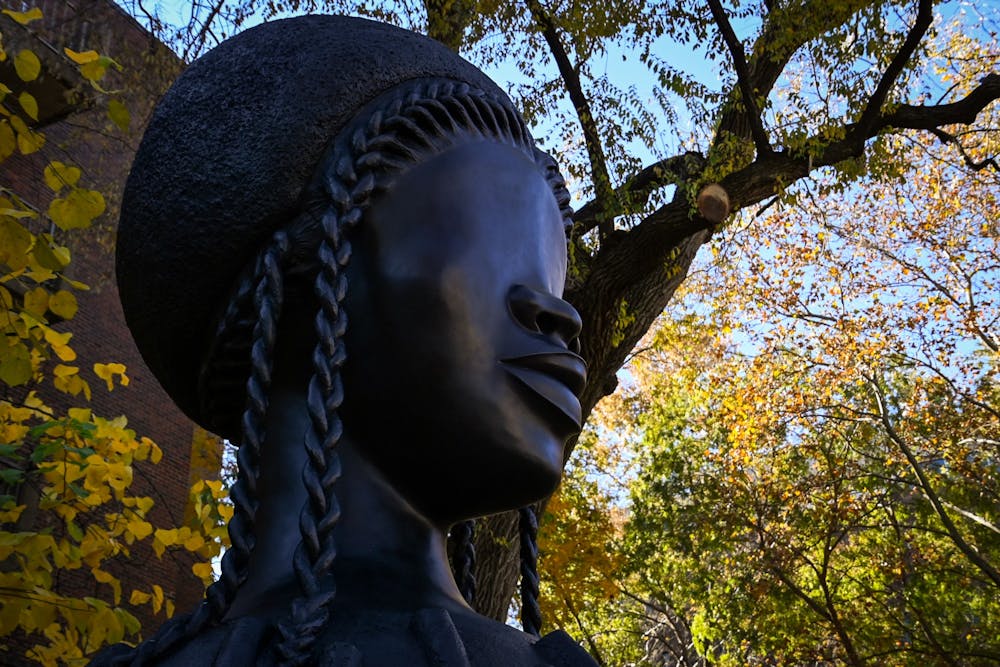Last week, Penn President Amy Gutmann hailed a new statue on campus as a sign of the school's commitment to fighting racial injustice. But Black students at Penn called on the University to go beyond "performative" gestures and meet student demands for increased funding for Black student groups.
On Nov. 10, Penn placed “Brick House,” a 16-foot tall statue sculpted by renowned Black artist Simone Leigh depicting a Black woman’s head atop a round structure, at the corner of 34th and Walnut streets. While Gutmann highlighted the statue’s placement in a prominent location on campus, Black students said the artwork was largely meaningless if it was not accompanied by concrete action to support the Black community at Penn.
“The statue itself isn’t bad. I think it’s wonderful to amplify Black art on campus,” College senior and Black Student League President Kristen Ukeomah said. “I just think it’s cognitive dissonance on behalf of the University to want to recognize Black people in ways that are not tangible or don’t have a larger impact.”
She said that Penn can do more to support Black students by providing more funding for Black student groups, working to increase retention rates for Black students, and moving the three cultural houses to a prominent location on Locust Walk — a demand that Penn's main minority coalition groups, the 6B, has been making for years.
“There is still so much work to be done,” Ukeomah said. “The statue does not rectify all of Penn’s harm.”
Penn announced on Tuesday it will contribute $100 million to the School District of Philadelphia over the next 10 years, the largest private contribution in the school district's history. The announcement comes as the University had faced widespread criticism from students and faculty for its refusal to make Payments in Lieu of Taxes, known as PILOTs, to the city of Philadelphia.
Ukeomah said while the contribution is a "good step" toward supporting Black students in Philadelphia, she hopes that Penn will not stop its contributions to Philadelphia schools after 10 years.

RELATED:
Penn pledges $100 million to Philadelphia public schools to address environmental hazards
Penn’s latest campus sculpture aims to celebrate Black womanhood
Undergraduate Assembly President and College senior Mercedes Owens agreed with Ukeomah's demands for more funding allocated for Black student programming, adding that Penn must also examine its involvement in policing, as well as its role in perpetuating Black violence and bias on campus.
“I think it’s important to have Black art and support Black artists in this way,” Owens said. “The problem is not with Simone Leigh or with the creation of this work. The problem is with how Penn branded it and the way that they framed them placing this work. Just because they place a sculpture [on campus] does not mean we’re going to be any less demanding of them to actually take action.”
Owens added that she would like to see clearer communication from Penn regarding events in West Philadelphia, such as the police killing of Walter Wallace Jr.
Two Philadelphia police officers shot and killed Wallace Jr., a 27-year-old Black man, on Oct. 26, prompting protests near Penn's campus and throughout West Philadelphia. Owens said she wanted to see University administrators explicitly state that Wallace was murdered in their email to the Penn community and outline clear steps as to how Penn would combat policing in Philadelphia. The email referred to Wallace Jr.'s killing as a "death" with no mention of the word "police," prompting backlash from students.
“I don’t think Penn should have placed this sculpture, especially branded as a commitment to end racial injustice on campus, until the administration is ready to have the conversation about internal evaluations of its involvement in policing, perpetuating Black violence and bias on campus, and how it plans to support the Black community, whether that means students, staff, faculty, or the West Philadelphia community,” Owens said.
Like Ukeomah and Owens, Wharton senior Sire Woods commended the University for displaying Black art in a prominent area on campus but said Penn still has more work to do to address racial justice.
“It’s really cool that they were able to put this on a majority-white campus to show the power of the Black woman in America,” Woods said. “I feel like they’re starting to make strides towards educating more [people about racial injustice], which is the first step."
Graduate School of Education third-year Christopher Rogers said, however, the statue's “symbol of Blackness” on campus is hypocritical because of Penn’s role in displacing thousands of Black residents when it expanded in the mid 1900s, replacing what was known as the “Black Bottom" between 32nd and 40th streets with University City.
He added that the placement of the statue is not an example of racial justice work, and Penn must instead invest in marginalized communities and rectify the harm the University has caused the West Philadelphia community.
Rogers, a member of Police Free Penn, participated in a peaceful protest on Friday calling on the Board of Trustees to discuss the role of Penn Police, Penn’s investment in the fossil fuel industry, and the University’s previous refusal to pay PILOTs at Friday's board meeting. The participants marched from 40th and Locust streets to the corner of 34th and Walnut streets where they gathered around the statue.
“[The action] was an opportunity to address this symbolic way of saying that Penn is on its way to progress in terms of racial justice issues, when in many ways they have failed to confront all of the ways in which [it is] institutionally invested in systems that harm Black people and Black communities,” Rogers said.









